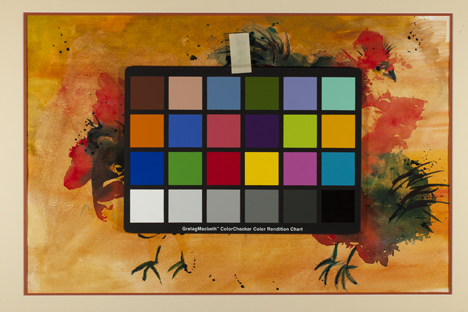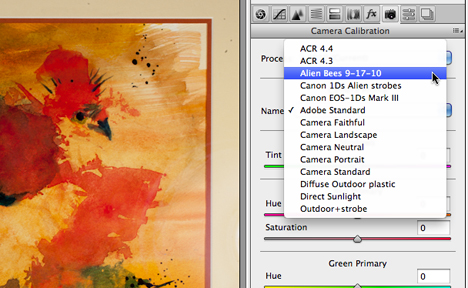This blog originally appeared on What They Think in September, 2010. I have updated it here with new information about fine art reproduction.
In my last two blogs I discussed the process of reproducing fine art. So far we have lighting and polarizing, both of which are discussed in detail:
With the images captured on my memory card, I moved to the process of making a camera profile. There are two ways to do this, one is to make a color profile that works in Adobe Photoshop’s Camera Raw pane. The other is to make a camera profile as an ICC profile to be applied to an image after it is open in Photoshop. I chose to use the Camera Raw process.
In this image I placed the large Gretag ColorChecker card. Now part of X-Rite, the company has been making this exact color card for decades. I could have used the smaller ColorChecker Passport, but it’s unimportant.
To make a profile for Camera Raw, one needs a DNG file, which my camera does not make. I could have used Adobe’s DNG Converter software to make a DNG from one of my Camera Raw images, but chose instead to make a DNG from the Raw pane in Photoshop. To do this I opened one of my properly-exposed images (containing the Passport color card) in Raw, then chose the Save Image button in the lower-left corner of that pane.
This is the ColorChecker Passport interface. It (usually) finds the ColorChecker pattern automatically in an image, and then makes a profile for the camera and lighting that is automatically made available in Photoshop’s Camera Raw palette. The software works nicely, and the profiles are effective.
In that pane I can choose to Save an image in TIFF, DNG, Photoshop and JPEG formats without opening the image in Photoshop. I chose DNG and saved the file. Then I dragged that DNG file onto the ColorChecker Passport software. It located the 24 color patches very quickly, and then allowed me to make a profile. The resulting file is saved in the appropriate folder for Photoshop.
This is the Camera Profile menu within Adobe Camera Raw. The camera profiles made by ColorChecker Passport are made available here. They also work in Adobe Lightroom.
Back in Photoshop, I opened one of the properly-exposed images of the painting that did not have the color target, then applied the newly-minted profile from the Camera tab in the Camera Raw pane, chose the highest native resolution possible, and opened the image. The other thing that is critical in fine art reproduction is to set the color temperature correctly in Camera Raw. My new strobe lights (not those I used in this example) are Einsteins, and those maintain a nearly perfect 5200 Kelvin color temperature at all intensities. I type 5200 into the Color Temperature value in Camera Raw, and the color of the original (corrected by the Passport profile) is nearly perfect.
So, now I had a color-correct image in my computer, and all that remained was to print it on my wide-format Epson ink-jet printer.
Which is no simple task.
I had not profiled my printer since my ill-fated installation of Snow Leopard back in summer ’09. That was catastrophic, and I still must print from a pre-Snow Leopard computer to use the correct Epson drivers. The way I finally solved this problem was to purchase a Mac Mini, and install Leopard (OS-X 10.5) on it, along with my older copy of the Creative Suite CS4. Now, using Screen Sharing, I print all of my work to the Epson printer using the Mac Mini. It’s a great solution to an insoluble solution with newer operating systems.
I printed the targets on my favorite paper (Epson Premium Luster) and then took them to school to read on the iOne Isis and the new iOne iO table. With spectrophotometric data in-hand, I built printer profiles for my Epson, and made a couple of prints of the painting to-size.
These prints were a bit too contrasty, so I modified the image with a curve in Photoshop, one which would open-up the midtones a bit, and flatten the image overall. The second printing was superb!
The painter was happy with my prints, and I am happy that I had success with this project.
Next assignment: reproduce an oil painting!
____
I’m writing a new book about printing processes and prepress. Click on the link below to give me your e-mail address, and I will let you know when the book is published (target date is March, 2012).





